Abstract
1. Senile muscle atrophy is characterized by a marked reduction in the frequency of spontaneous transmitter release with no electrophysiological evidence of denervation.
2. In spite of the reduced number of muscle fibres, there is no ultrastructural evidence for denervation at the end-plates. There is agglutination of synaptic vesicles, neurotubules and filaments, thickening of the basement membrane, widening of the primary synaptic cleft, and irregular branching of the junctional infoldings, but no axonal degeneration.
3. The contractile process in senile muscles is slowed down as is indicated by a prolongation of contraction time, latency period, maximum rate of twitch tension and relaxation time.
4. The muscle fibres show proliferation of the T system and increased SR but no fragmentation as is observed in denervation atrophy.
5. Senile muscle atrophy thus presents some specific features affecting both pre- and post-synaptic structures, related to a very slow process of deterioration of the neuromuscular contact.
Full text
PDF
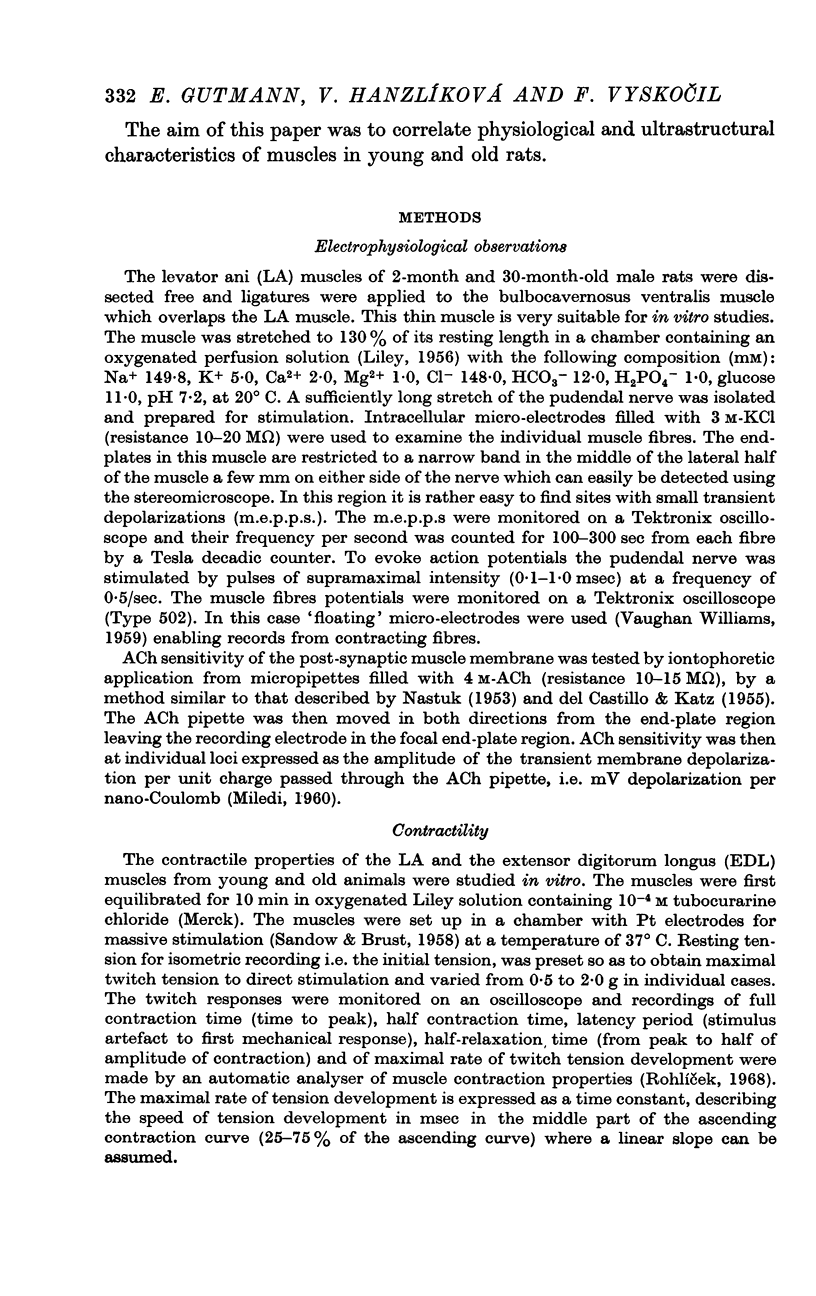
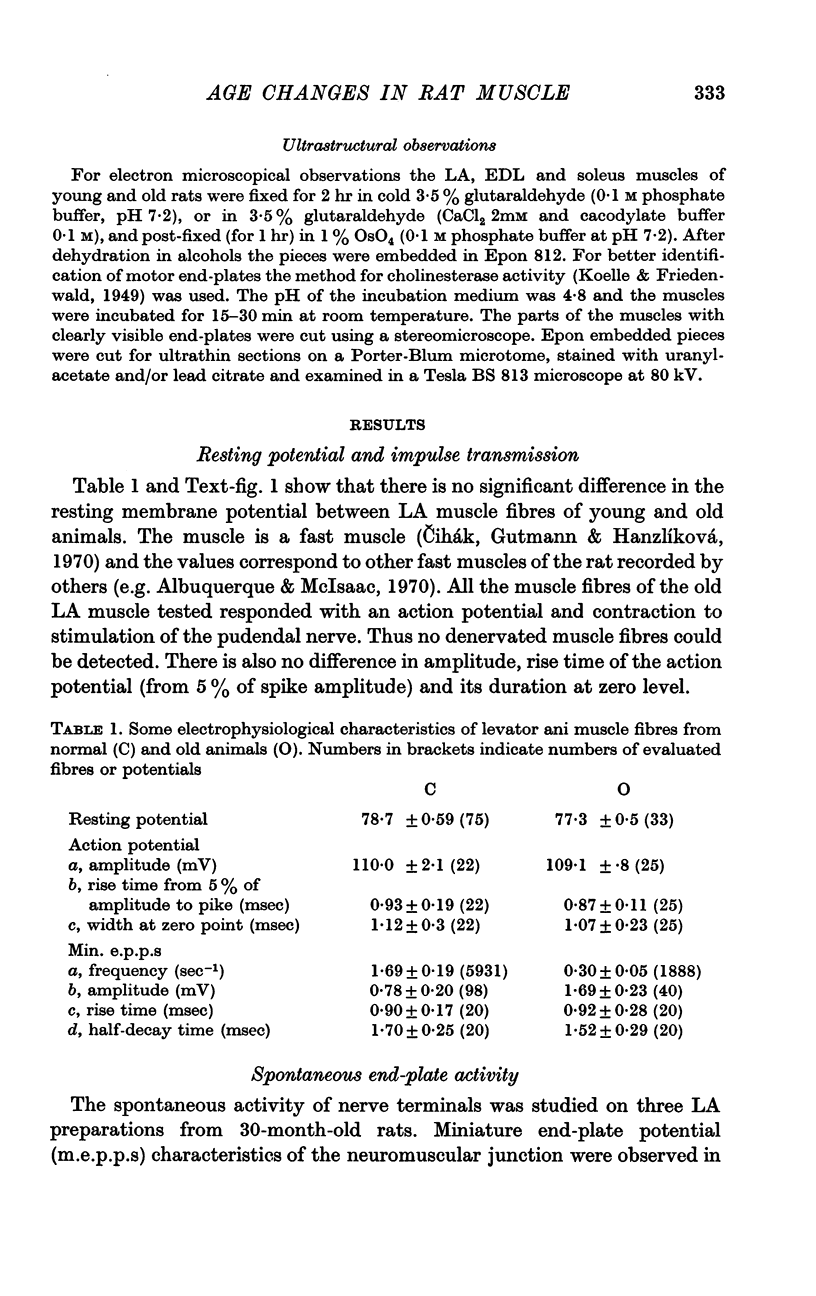

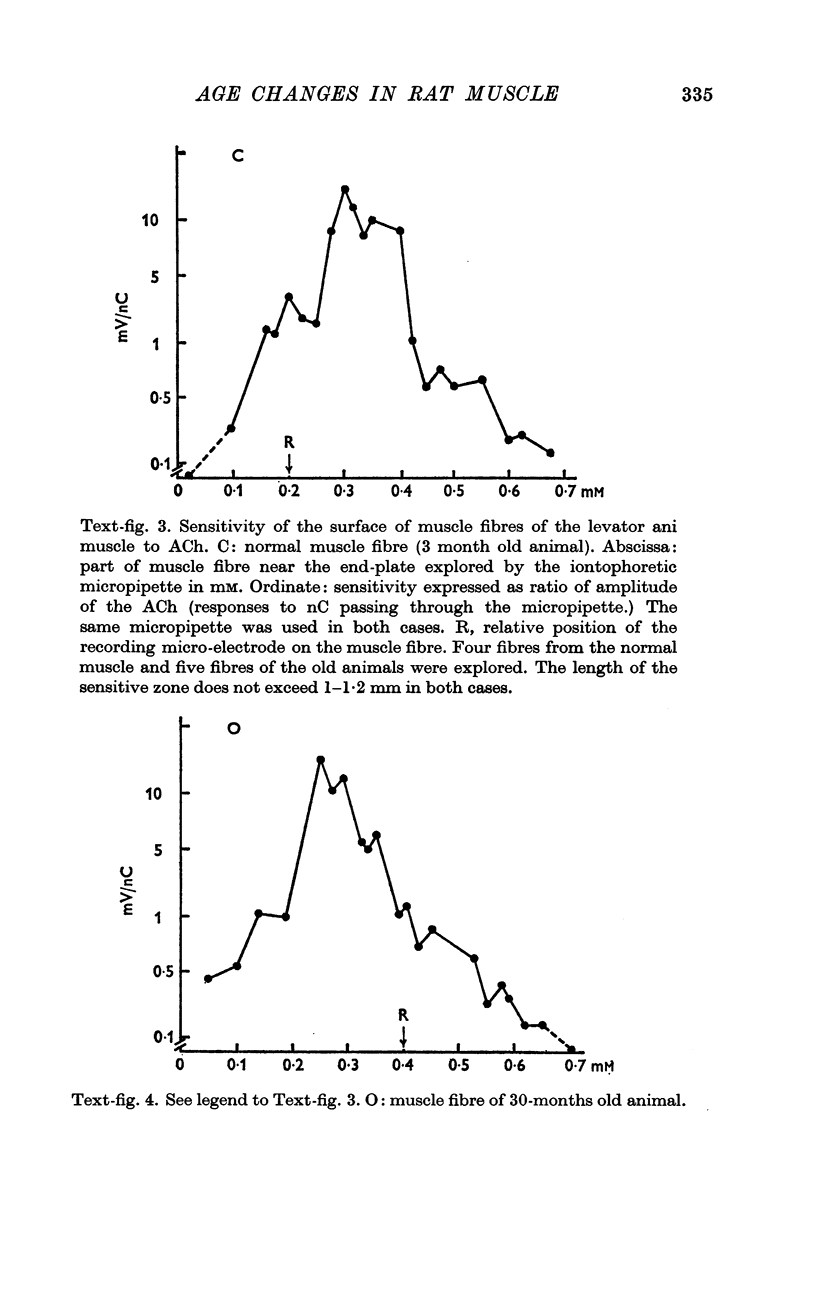
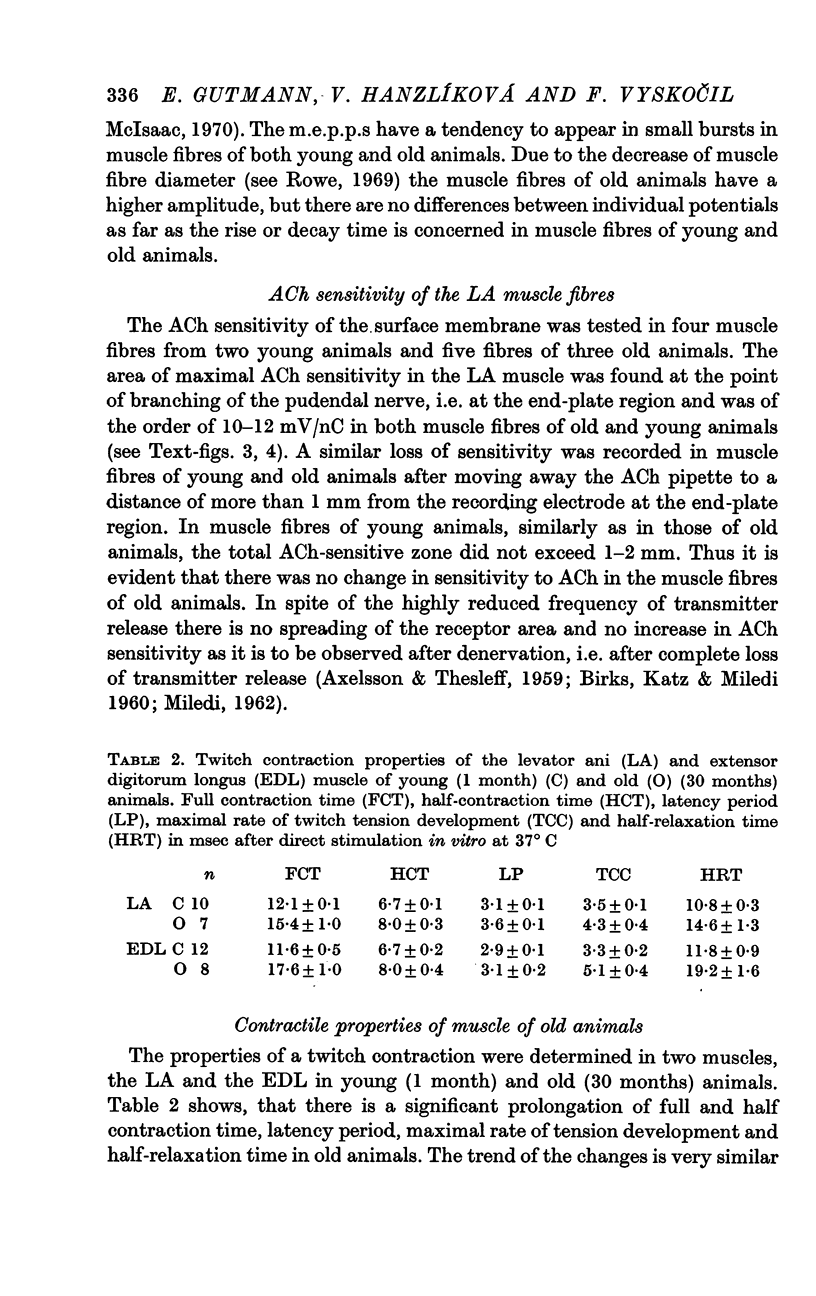

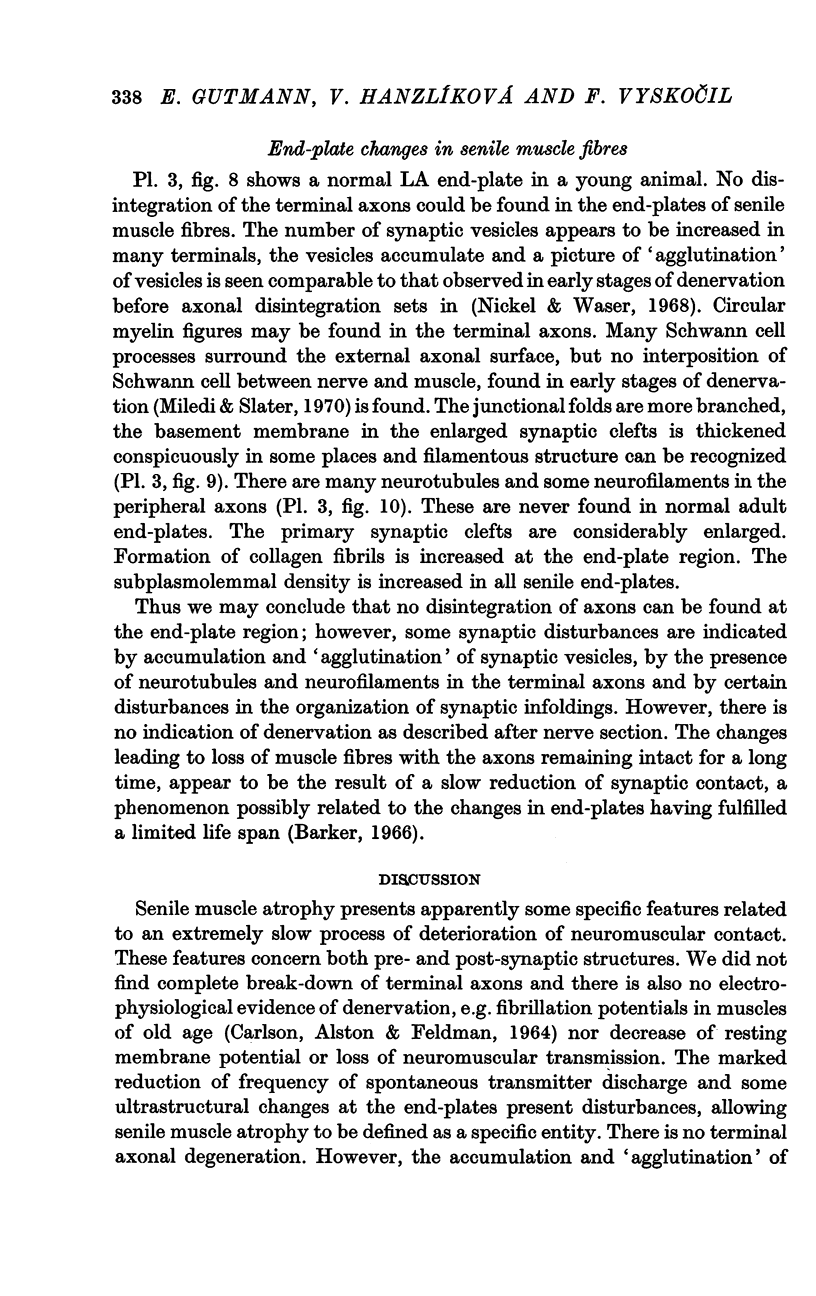
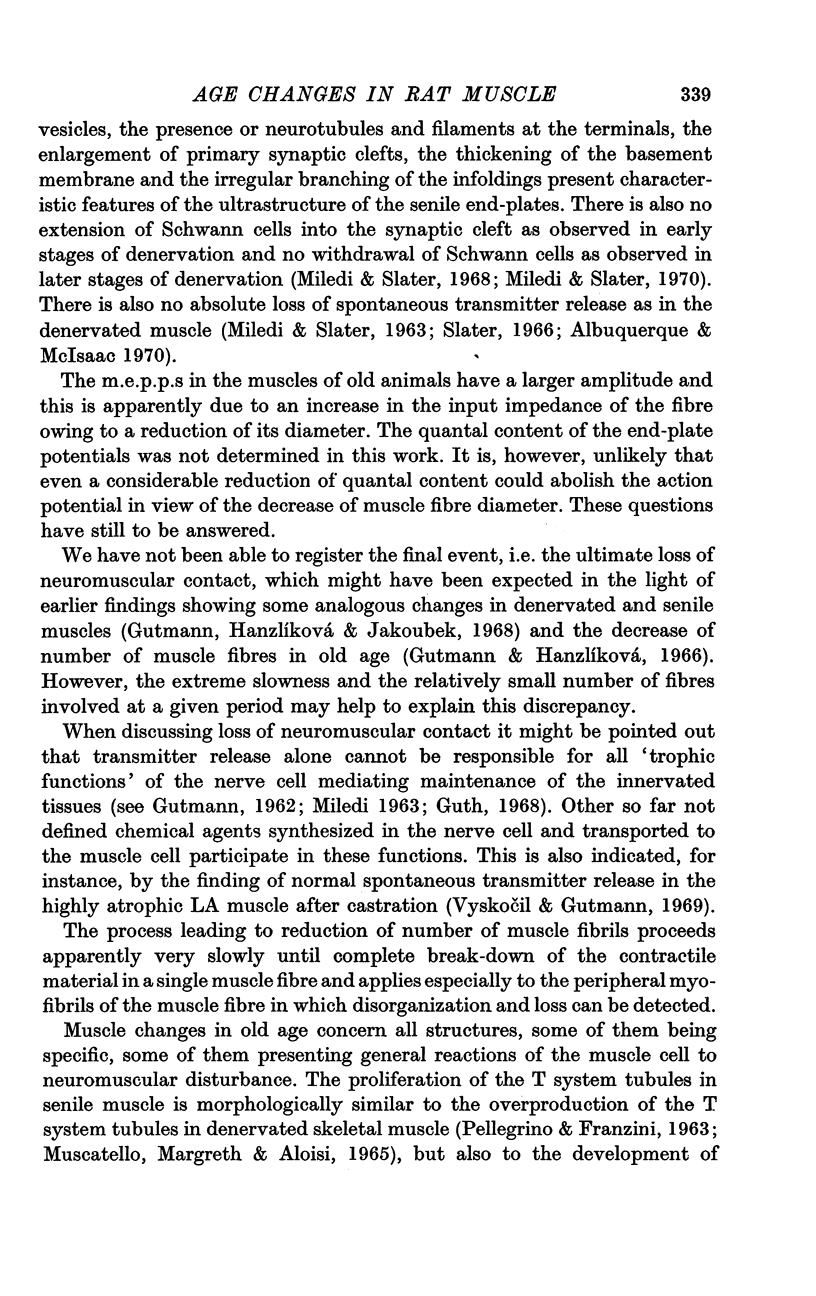
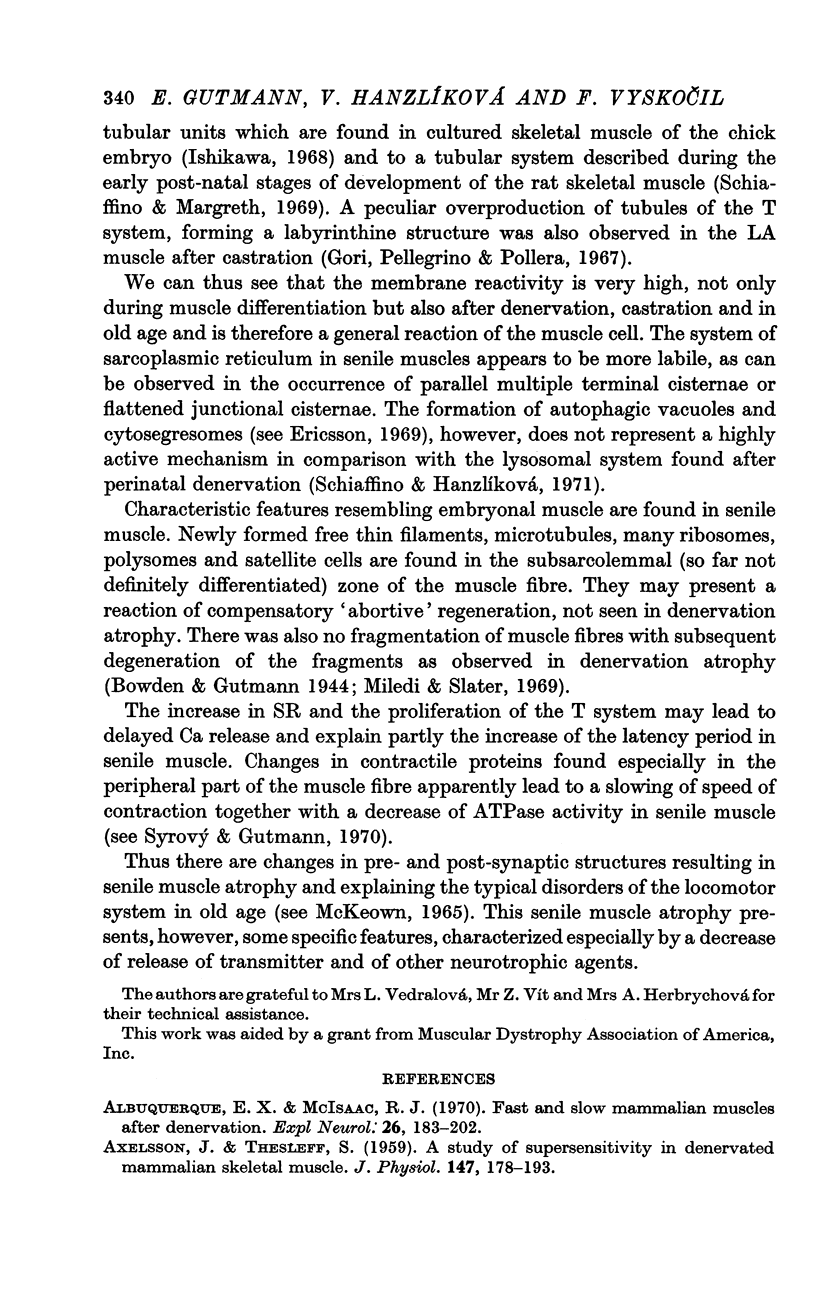
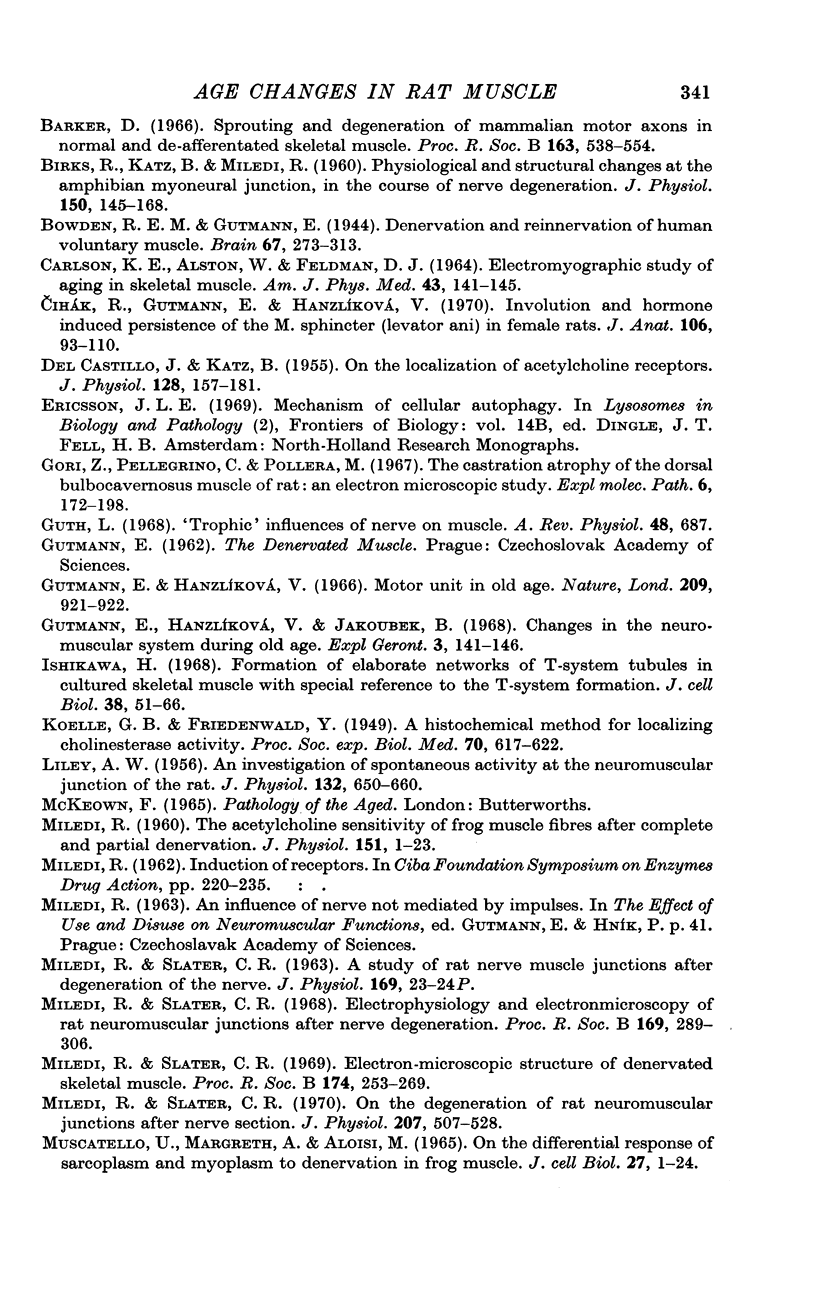



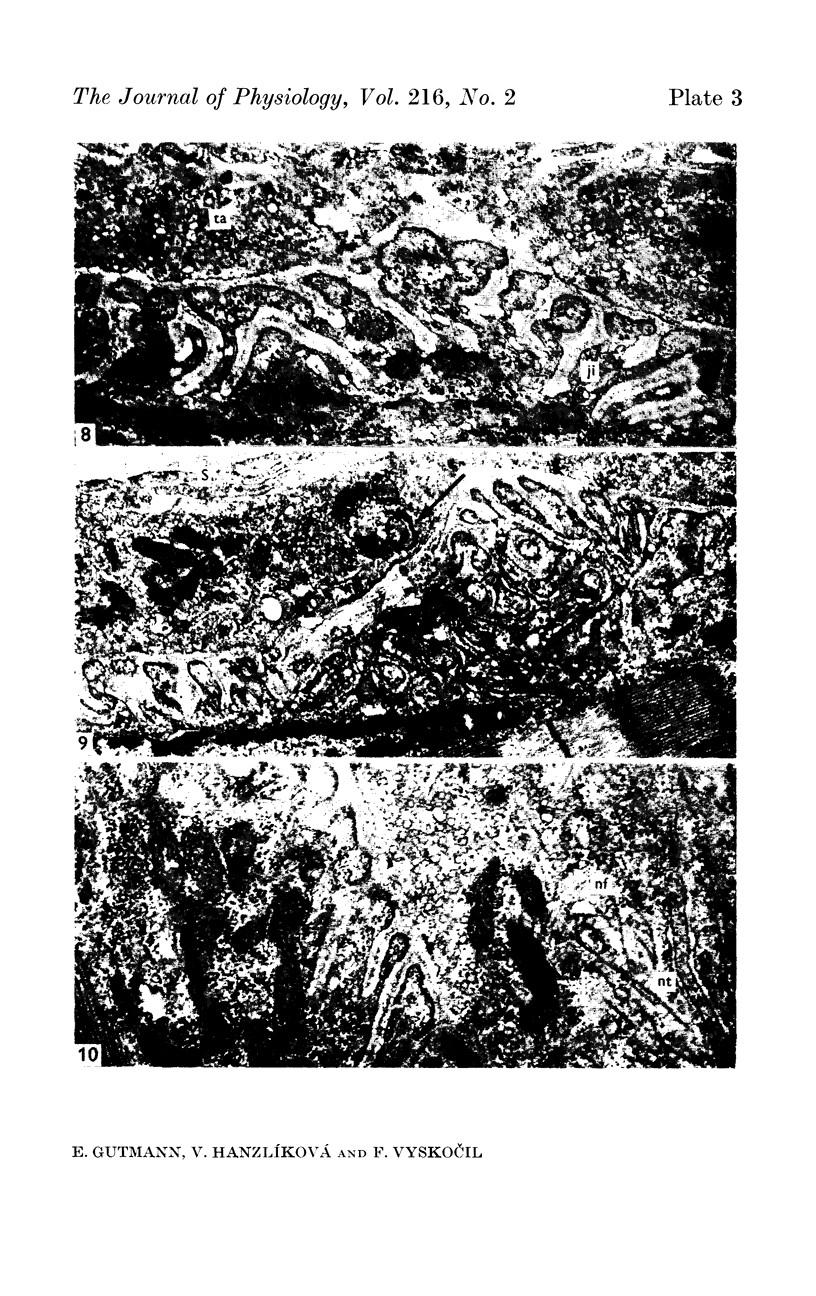
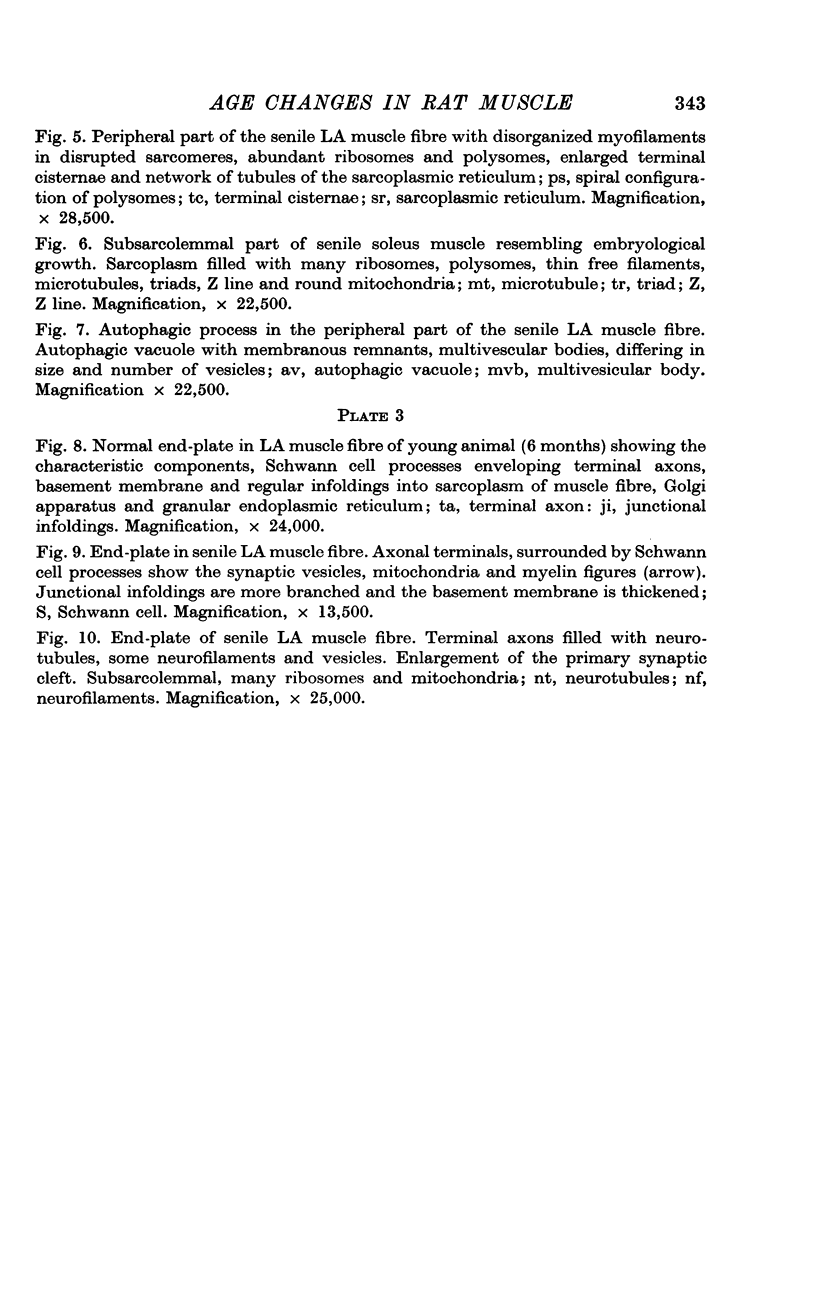
Images in this article
Selected References
These references are in PubMed. This may not be the complete list of references from this article.
- AXELSSON J., THESLEFF S. A study of supersensitivity in denervated mammalian skeletal muscle. J Physiol. 1959 Jun 23;147(1):178–193. doi: 10.1113/jphysiol.1959.sp006233. [DOI] [PMC free article] [PubMed] [Google Scholar]
- Arvill A., Ahrén K. Effects of insulin on the intact levator ani muscle of the rat. I. Effects on the accumulation of alpha-aminoisobutyric acid and D-xylose. Acta Endocrinol (Copenh) 1967 Oct;56(2):279–294. doi: 10.1530/acta.0.0560279. [DOI] [PubMed] [Google Scholar]
- BIRKS R., KATZ B., MILEDI R. Physiological and structural changes at the amphibian myoneural junction, in the course of nerve degeneration. J Physiol. 1960 Jan;150:145–168. doi: 10.1113/jphysiol.1960.sp006379. [DOI] [PMC free article] [PubMed] [Google Scholar]
- BLEEHEN N. M., FISHER R. B. The action of insulin in the isolated rat heart. J Physiol. 1954 Feb 26;123(2):260–276. doi: 10.1113/jphysiol.1954.sp005049. [DOI] [PMC free article] [PubMed] [Google Scholar]
- Barker D., Ip M. C. Sprouting and degeneration of mammalian motor axons in normal and de-afferentated skeletal muscle. Proc R Soc Lond B Biol Sci. 1966 Jan 18;163(993):538–554. doi: 10.1098/rspb.1966.0008. [DOI] [PubMed] [Google Scholar]
- CARLSON K. E., ALSTON W., FELDMAN D. J. ELECTROMYOGRAPHIC STUDY OF AGING IN SKELETAL MUSCLE. Am J Phys Med. 1964 Aug;43:141–145. [PubMed] [Google Scholar]
- Cihák R., Gutmann E., Hanzlíková V. Involution and hormone-induced persistence of the M. sphincter (levator) ani in female rats. J Anat. 1970 Jan;106(Pt 1):93–110. [PMC free article] [PubMed] [Google Scholar]
- DEL CASTILLO J., KATZ B. On the localization of acetylcholine receptors. J Physiol. 1955 Apr 28;128(1):157–181. doi: 10.1113/jphysiol.1955.sp005297. [DOI] [PMC free article] [PubMed] [Google Scholar]
- FISHER R. B., LINDSAY D. B. The action of insulin on the penetration of sugars into the perfused heart. J Physiol. 1956 Mar 28;131(3):526–541. doi: 10.1113/jphysiol.1956.sp005480. [DOI] [PMC free article] [PubMed] [Google Scholar]
- Gori Z., Pellegrino C., Pollera M. The castration atrophy of the dorsal bulbocavernosus muscle of rat: an electron microscopic study. Exp Mol Pathol. 1967 Apr;6(2):172–198. doi: 10.1016/0014-4800(67)90054-8. [DOI] [PubMed] [Google Scholar]
- Guth L. "Trophic" influences of nerve on muscle. Physiol Rev. 1968 Oct;48(4):645–687. doi: 10.1152/physrev.1968.48.4.645. [DOI] [PubMed] [Google Scholar]
- Gutmann E., Hanzlíková V., Jakoubek B. Changes in the neuromuscular system during old age. Exp Gerontol. 1968 Aug;3(2):141–146. doi: 10.1016/0531-5565(68)90022-3. [DOI] [PubMed] [Google Scholar]
- Gutmann E., Hanzlíková V. Motor unit in old age. Nature. 1966 Feb 26;209(5026):921–922. doi: 10.1038/209921b0. [DOI] [PubMed] [Google Scholar]
- HENDERSON M. J., MORGAN H. E., PARK C. R. Regulation of glucose uptake in muscle. V. The effect of growth hormone on glucose transport in the isolated, perfused rat heart. J Biol Chem. 1961 Aug;236:2157–2161. [PubMed] [Google Scholar]
- Ishikawa H. Formation of elaborate networks of T-system tubules in cultured skeletal muscle with special reference to the T-system formation. J Cell Biol. 1968 Jul;38(1):51–66. doi: 10.1083/jcb.38.1.51. [DOI] [PMC free article] [PubMed] [Google Scholar]
- LILEY A. W. An investigation of spontaneous activity at the neuromuscular junction of the rat. J Physiol. 1956 Jun 28;132(3):650–666. doi: 10.1113/jphysiol.1956.sp005555. [DOI] [PMC free article] [PubMed] [Google Scholar]
- MILEDI R. The acetylcholine sensitivity of frog muscle fibres after complete or partial devervation. J Physiol. 1960 Apr;151:1–23. [PMC free article] [PubMed] [Google Scholar]
- MORGAN H. E., REGEN D. M., HENDERSON M. J., SAWYER T. K., PARK C. R. Regulation of glucose uptake in muscle. VI. Effects of hypophysectomy, adrenalectomy, growth hormone, hydrocortisone, and insulin on glucose transport and phosphorylation in the perfused rat heart. J Biol Chem. 1961 Aug;236:2162–2168. [PubMed] [Google Scholar]
- Miledi R., Slater C. R. Electron-microscopic structure of denervated skeletal muscle. Proc R Soc Lond B Biol Sci. 1969 Nov 18;174(1035):253–269. doi: 10.1098/rspb.1969.0091. [DOI] [PubMed] [Google Scholar]
- Miledi R., Slater C. R. Electrophysiology and electron-microscopy of rat neuromuscular junctions after nerve degeneration. Proc R Soc Lond B Biol Sci. 1968 Feb 27;169(1016):289–306. doi: 10.1098/rspb.1968.0012. [DOI] [PubMed] [Google Scholar]
- Miledi R., Slater C. R. On the degeneration of rat neuromuscular junctions after nerve section. J Physiol. 1970 Apr;207(2):507–528. doi: 10.1113/jphysiol.1970.sp009076. [DOI] [PMC free article] [PubMed] [Google Scholar]
- Muscatello U., Margreth A., Aloisi M. On the differential response of sarcoplasm and myoplasm to denervation in frog muscle. J Cell Biol. 1965 Oct;27(1):1–24. doi: 10.1083/jcb.27.1.1. [DOI] [PMC free article] [PubMed] [Google Scholar]
- Nickel E., Waser P. G. Elektronenmikroskopische Untersuchungen am Diaphragma der Maus nach einseitiger Phrenikotomie. I. Die degenerierende motorische Endplatte. Z Zellforsch Mikrosk Anat. 1968;88(2):278–296. [PubMed] [Google Scholar]
- OPIE L. H., EVANS J. R., SHIPP J. C. EFFECT OF FASTING ON GLUCOSE AND PALMITATE METABOLISM OF PERFUSED RAT HEART. Am J Physiol. 1963 Dec;205:1203–1208. doi: 10.1152/ajplegacy.1963.205.6.1203. [DOI] [PubMed] [Google Scholar]
- Rowe R. W. The effect of senility on skeletal muscles in the mouse. Exp Gerontol. 1969 Jul;4(2):119–126. doi: 10.1016/0531-5565(69)90034-5. [DOI] [PubMed] [Google Scholar]
- SANDOW A., BRUST M. Contractility of dystrophic mouse muscle. Am J Physiol. 1958 Sep;194(3):557–563. doi: 10.1152/ajplegacy.1958.194.3.557. [DOI] [PubMed] [Google Scholar]
- Schiaffino S., Margreth A. Coordinated development of the sarcoplasmic reticulum and T system during postnatal differentiation of rat skeletal muscle. J Cell Biol. 1969 Jun;41(3):855–875. doi: 10.1083/jcb.41.3.855. [DOI] [PMC free article] [PubMed] [Google Scholar]
- Schiaffino S., Settembrini P. Studies on the effect of denervation in developing muscle. I. Differentiation of the sarcotubular system. Virchows Arch B Cell Pathol. 1970;4(4):345–356. doi: 10.1007/BF02906089. [DOI] [PubMed] [Google Scholar]
- Slater C. R. Time course of failure of neuromuscular transmission after motor nerve section. Nature. 1966 Jan 15;209(5020):305–306. doi: 10.1038/209305b0. [DOI] [PubMed] [Google Scholar]
- Vyskocil F., Gutmann E. Spontaneous transmitter release from motor nerve endings in muscle fibres of castrated and old animals. Experientia. 1969 Sep 15;25(9):945–946. doi: 10.1007/BF01898080. [DOI] [PubMed] [Google Scholar]
- WILBRANDT W., ROSENBERG T. The concept of carrier transport and its corollaries in pharmacology. Pharmacol Rev. 1961 Jun;13:109–183. [PubMed] [Google Scholar]
- Young D. A. A photoperiodic influence on growth in rats. J Exp Zool. 1965 Nov;160(2):241–246. doi: 10.1002/jez.1401600212. [DOI] [PubMed] [Google Scholar]
- Young D. A. Factors controlling the washout of the interstitial space of the isolated, perfused rat heart. J Physiol. 1968 Jun;196(3):747–759. doi: 10.1113/jphysiol.1968.sp008534. [DOI] [PMC free article] [PubMed] [Google Scholar]
- Young D. A. Hypothalamic (photoperiodic) control of a seasonal antagonism to insulin in the rat heart. J Physiol. 1965 Jun;178(3):530–543. doi: 10.1113/jphysiol.1965.sp007640. [DOI] [PMC free article] [PubMed] [Google Scholar]
- ZACHARIAH P. Contractility and sugar permeability in the perfused rat heart. J Physiol. 1961 Sep;158:59–72. doi: 10.1113/jphysiol.1961.sp006754. [DOI] [PMC free article] [PubMed] [Google Scholar]












